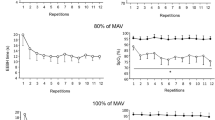Abstract
Elevated oxygen uptake (V˙O2) during moderate-intensity running following a bout of interval running training has been studied previously. To further investigate this phenomenon, the V˙O2 response to high-intensity exercise was examined following a bout of interval running. Well-trained endurance runners were split into an experimental group [maximum oxygen uptake, V˙O2 max 4.73 (0.39) l · min−1] and a reliability group [V˙O2 max 4.77 (0.26) l · min−1]. The experimental group completed a training session (4 × 800 m at 1 km · h−1 below speed at V˙O2 max , with 3 min rest between each 800-m interval). Five minutes prior to, and 1 h following the training session, subjects completed 6 min 30 s of constant speed, high-intensity running designed to elicit 40% Δ (where Δ is the difference between V˙O2 at ventilatory threshold and V˙O2 max ; tests 1 and 2, respectively). The slow component of V˙O2 kinetics was quantified as the difference between the V˙O2 at 6 min and the V˙O2 at 3 min of exercise, i.e. ΔV˙O2(63). The ΔV˙O2(63) was the same in two identical conditions in the reliability group [mean (SD): 0.30 (0.10) l · min−1 vs 0.32 (0.13) l · min−1]. In the experimental group, the magnitude of the slow component of V˙O2 kinetics was increased in test 2 compared with test 1 by 24.9% [0.27 (0.14) l · min−1 vs 0.34 (0.08) l · min−1, P < 0.05]. The increase in ΔV˙O2(63) in the experimental group was observed in the absence of any significant change in body mass, core temperature or blood lactate concentration, either at the start or end of tests 1 or 2. It is concluded that similar mechanisms may be responsible for the slow component of V˙O2 kinetics and for the fatigue following the training session. It has been suggested previously that this mechanism may be linked primarily to changes within the active limb, with the recruitment of alternative and/or additional less efficient fibres.
Similar content being viewed by others
Author information
Authors and Affiliations
Additional information
Accepted: 9 September 1998
Rights and permissions
About this article
Cite this article
James, D., Doust, J. Oxygen uptake during high-intensity running: response following a single bout of interval training. Eur J Appl Physiol 79, 237–243 (1999). https://doi.org/10.1007/s004210050501
Issue Date:
DOI: https://doi.org/10.1007/s004210050501




